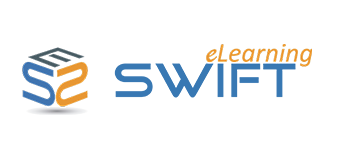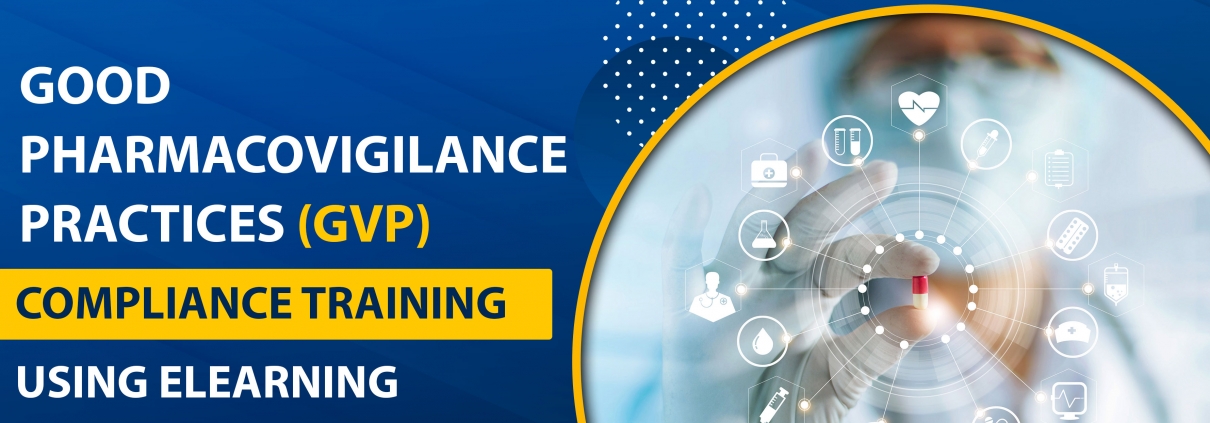Good Pharmacovigilance Practices (GVP) Compliance Training Using eLearning
What is GVP Compliance training?
GVP Compliance training is a program for pharmaceutical professionals to learn how to follow rules and guidelines in monitoring and reporting the safety of drugs, ensuring they meet regulatory standards and protect public health.
Introduction:
In recent years, eLearning has emerged as a powerful tool for delivering effective and efficient training across various industries. The pharmaceutical sector is no exception, and leveraging eLearning for GVP compliance training brings numerous benefits, including flexibility, cost-effectiveness, and enhanced engagement.
Good Pharmacovigilance Practices (GVP) Compliance training offers industry guidance on good pharmacovigilance practices and pharmacoepidemiologic evaluation of observational data on pharmaceuticals, including biological drug products (excluding blood components).
It specifically guides on:
- Safety signal identification
- Pharmacoepidemiologic safety signal interpretation, and assessment
- Pharmacovigilance project development
Why is pharmacovigilance important?
The World Health Organization (WHO) defined Pharmacovigilance as “the science and activities relating to the detection, assessment, understanding, and prevention of adverse effects or any other drug-related problem”.
WHO specifies that any newly developed drug must meet three critical conditions before approval by its respective regulatory agency?
- Effectiveness
- Good quality
- Safety for intended purposes
Pharmacovigilance (PV) is central to drug safety. PV analysis conducted in Phase I, Phase II, and Phase III clinical trials gives the drug company’s data on the safety profile of the drug. This data can be used for additional research and development (R&D) if necessary, or it can be submitted to regulatory authorities to gain access to new markets.
In clinical research, PV offers valuable insights into the safety profile of pharmaceutical drugs, both by manufacturing methods and by medical professionals and consumers.
When a new adverse reaction in a drug is recognized, the label’s list of side effects must be up-to-date. PV data can sometimes result in the removal of a drug from the market (drug recall) due to dangerous side effects. The main objectives that Good Pharmacovigilance Practices (GVP) compliance applicable to pharmaceuticals are:
- Promoting the safe and effective use of pharmaceutical products, particularly by providing timely information about the safety of medical products to patients, healthcare professionals, and the general public
- The terms of marketing authorization or occupational exposure, preventing harm from a negative response in humans, arising from the use of authorized medicinal products within or outside.
Pharmacovigilance activities are organized by separate but connected processes, and each GVP module presents one major pharmacovigilance process. Additionally, GVP provides guidance on the conduct of pharmacovigilance for specific product types or populations in which medicines are used. These GVP considerations must be used in conjunction with the process-related guidance provided in the modules.
What do the training courses on Good Pharmacovigilance Practices contain?
Good Vigilance Practices Compliance courses deal with:
- The basics of good pharmacology and current legal rules and regulations
- Outlining the main GVP requirements for pharmacovigilance and risk management systems
- The essential documents related to GVP and understand the essence, purpose, and structure of important case-related files such as the Pharmaceutical System Master File (PSMF), Periodic Safety Update Report (PSUR) and Study Protocol.
Why is e-learning the best strategy for GVP Compliance training?
Good Pharmacovigilance Practices Compliance training is very useful for employees particularly in the field of drug trials. Elearning can enhance this training by the use of the following strategies:
1) Micro learning
What is Micro learning?
MicroLearning is a brief and focused approach to learning that delivers small, targeted lessons to enhance specific skills or knowledge.
Micro learning can defined as a targeted short course, with a piece of content, or task (not more than five to ten minutes) that focuses on a single learning objective. Micro-learning is a very effective form of learning as they focus on one topic at a time, decreasing load on the learner. It might be in the form of a single concept or scenario, infographics or interactive PDF, a short educational or instructional video or animation, or a brief webinar.
The concept of GVP Compliance is vast and consists of various topics that can be lengthy. With micro learning, you can divide these topics into chunks of smaller modules that can be grasped easily.
2) Scenario based learning
What is Scenario based learning?
Scenario-Based Learning is an instructional approach that uses real-life situations to facilitate learning.
Scenario Based Training changes the learning experience from passive to in-depth. The employee can interact with the course, by making real-life decisions in a risk-free environment, and understand the consequences of their decisions through constant feedback.
In Pharmacovigilance, an individual can experience different scenarios where his/her decision can be very crucial during documentation and verification of drug safety. Hence Scenario based learning can be of help during the training on GVP compliance.
3) ILT/VILT conversion to eLearning
What is ILT/VILT conversion to eLearning?
ILT/VILT Conversion into eLearning is the process of transforming traditional Instructor-Led Training (ILT) or Virtual Instructor-Led Training (VILT) sessions into digital, online formats, making educational content accessible through electronic means such as eLearning platforms.
Converting your ILT and VILT to eLearning courses is a quick and inexpensive process of providing training on an existing content. In an Instructor Led Training (ILT) the training takes place in the presence of a trainer and facilitator who guides a group of learners through a session either in a classroom or virtually. In this, your existing digital assets, content, and learning strategies can be transformed into effective virtual eLearning courses in a remarkable short time frame.
4) Simulation-based training
What is Simulation-based eLearning?
Simulation-based eLearning entails training modules that utilize simulated environments to replicate real-world software usage, enabling learners to practice and enhance their skills in a risk-free setting.
Software simulations can help in training on the software tools required in pharmacovigilance researches by providing an immersive software experience for the learner to learn the different aspects of a software and receiving feedback.
5) Translation and localization
What is Translation and localization?
Translation and Localization of eLearning involves adapting an online course to various languages and cultures, making it clear and relevant for diverse global audiences.
With the use of translation and localization services of eLearning, you will be able to provide training in different languages, enabling you to reach a wider range of audiences.
The workforce at Pharmacovigilance firms is usually diverse, with people from different cultural and ethnical backgrounds. Translating courses to the language they are comfortable in, helps in better engagement during training.
6) Tracking employees compliant
What is Tracking and Monitoring?
Tracking and monitoring involve overseeing employees’ progress and performance within a learning platform to ensure they meet training goals.
eLearning when combined with the LMS platform, makes it easy to track the performance of your employees and have a documented data on the progress of their training.
Conclusion
In the dynamic landscape of pharmaceuticals, maintaining GVP compliance is non-negotiable for organizations committed to patient safety and regulatory adherence. The integration of eLearning into GVP compliance training not only addresses these requirements but also offers a modern, efficient, and cost-effective solution. By harnessing the power of eLearning, pharmaceutical companies can navigate the complexities of GVP regulations with agility, ensuring that their workforce is well-equipped to uphold the highest standards in drug safety.
Our eLearning Services
Corporate eLearning Solutions: Our corporate eLearning solutions offer customizable digital learning programs, such as onboarding modules, compliance training, leadership development courses, and skill enhancement workshops. These eLearning programs are designed to meet the unique training and development needs of businesses and organizations, with the goal of enhancing employee skills, knowledge, and performance within a corporate environment.
Read More
Convert Flash Game to Html5: Our conversion service seamlessly transforms Flash games into HTML5-compatible versions, ensuring smooth gameplay experiences across multiple devices and browsers, while adhering to modern web standards for optimal performance and accessibility.
Read More
Cost Effective Translation: We offer high-quality and accurate translation services at competitive prices, optimizing the balance between affordability and quality to meet the budgetary constraints of clients without compromising on linguistic precision or cultural nuances.
Read More
Frequently Asked Questions (FAQs)
How does eLearning enhance GVP compliance training?
eLearning enhances GVP compliance training by offering flexibility, cost-effectiveness, and interactive learning experiences. It allows employees to access training materials remotely, reduces costs associated with traditional training methods, and provides engaging content that improves information retention.
Can eLearning be customized to meet specific organizational needs in GVP compliance training?
Yes, eLearning modules can be customized to meet the specific needs and requirements of pharmaceutical organizations. This flexibility ensures that training aligns with the company’s policies, procedures, and any unique aspects of its pharmacovigilance system.
How does eLearning contribute to cost savings in GVP compliance training?
eLearning contributes to cost savings by eliminating expenses related to travel, accommodation, and venue rentals associated with traditional training methods. Additionally, the ability to update and distribute electronic materials reduces costs related to printed training materials.
What interactive features can be incorporated into eLearning for GVP compliance training?
eLearning for GVP compliance training can include interactive features such as quizzes, simulations, and multimedia elements. Real-life scenarios and case studies can also be integrated to provide practical insights into GVP compliance practices.
How does eLearning help in tracking and reporting for GVP compliance?
eLearning platforms offer robust tracking and reporting functionalities, allowing organizations to monitor employee progress and assess the effectiveness of the training program. Automated tracking simplifies the documentation required for regulatory audits, ensuring compliance with reporting requirements.
Can eLearning accommodate a globally dispersed workforce for GVP compliance training?
Yes, eLearning is well-suited for a globally dispersed workforce as it enables employees to access training materials remotely. This ensures that GVP compliance training can be conducted without geographical constraints, making it convenient for employees in different locations.







You’ve discovered something truly valuable!
We’re in the process of revamping our GVP compliance training, and your insights have given me a fresh perspective on how to approach it. Do you have any tips for designing eLearning modules for compliance training?
We are excited to hear that our insights have been beneficial for your GVP compliance training update!
Check out the article on creating accessible elearning content using WCAG 2.0 design methods.
The screenshots in this article are super helpful, especially for those looking to engage in custom elearning content development. Make it so much easier to follow along with the steps. Great job on the visual aids!